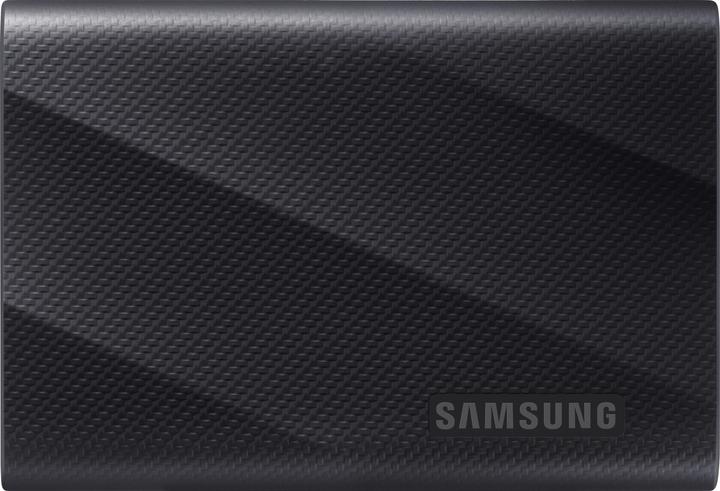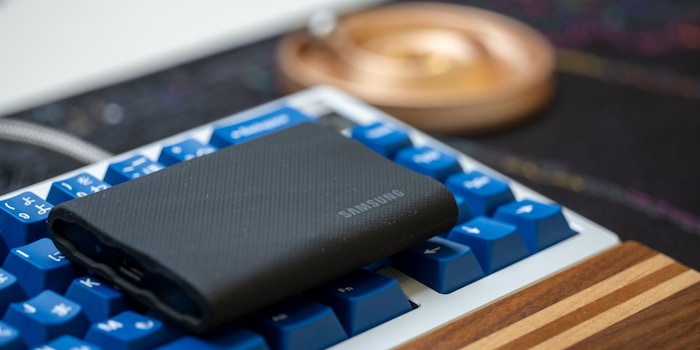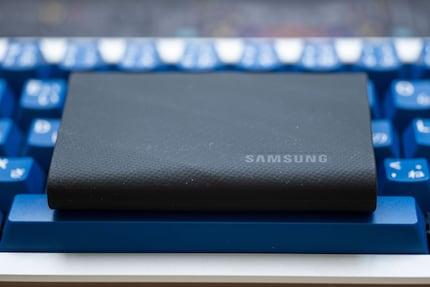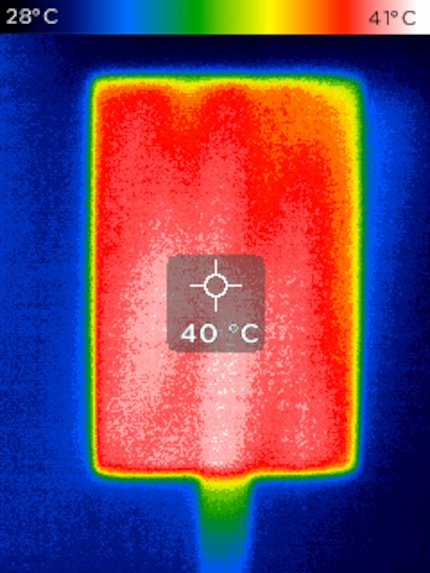

Samsung T9 portable SSD: large, heavy – and fast
After more than a three-year wait, Samsung has finally released the successor to the T7: the T9. Sporting a USB 3.2 Gen2x2, the T9 grinds its predecessor into dust during my tests. But the external SSD hasn’t just upped its performance – it’s also gained in size and weight.
The Kingston and Crucial SSDs I tested recently have something in common. Each fitted with a new controller, they’re smaller than previous external SSDs. The new Samsung T9, on the other hand, is more than 10 per cent larger than its predecessor, the T7 Shield. That being said, it also boasts double the transfer rate, making the SSD the fastest in its category right now.
A detailed look at the Samsung T9
At 88 × 60 × 14 millimetres, the T9 is the largest SSD I’ve got my hands on recently. Weighing in at 122 grammes, it’s almost 100 grammes heavier than the Kingston XS1000.
Like the T7 Shield, the T9 is encased in rubber. As a result, it can survive falls from heights of up to three metres. The T9 doesn’t come IP-certified because, unlike the T7 Shield, it’s neither dust- nor water-resistant.

Source: Kevin Hofer
The T9 is available with a storage capacity of 1, 2 or 4 terabytes (TB). As is the case for the T7, the Samsung Pablo is used as the controller. Unlike the x10 Pro, this means the T9 needs a bridge chip to translate from SATA/NVMe to the USB protocol. This also explains the T9’s dimensions – the bridge chip needs extra space.
Samsung uses 128-layer TLC for the 3D NAND memory. NAND is a non-volatile storage technology that doesn’t require power to store data. TLC stands for Triple Level Cell. This means 3 bits are allocated per memory cell. The SSD also offers 256-bit AES encryption and a five-year manufacturer warranty.
When it comes to data transfer, Samsung states a read and write speed of 2,000 megabytes per second (MB/s). At least, that’s the case for my 4-terabyte test device. For the smaller varieties, the manufacturer specifies a write speed of 1,950 MB/s.
The T9 comes with a USB 3.2 Gen2x2 interface, allowing theoretical transfer speeds of up to 2,000 MB/s. To achieve these speeds, your PC or notebook must support the USB 3.2 Gen2x2 standard. Although Thunderbolt 3 or 4 are faster on paper, they only allow transfer rates of up to 1,000 MB/s with the T9. This is because USB 3.2 Gen2x2 transmits via two lanes, while Thunderbolt 3 and 4 only transmit via one.
A USB-A to USB-C cable and a USB-C to USB-C cable come included with the SSD. Just bear in mind that the USB-C to USB-C cable is the only one able to support USB 3.2 Gen2x2. The other cable only allows transfer rates of up to 1,000 MB/s.
Sequential read and write speeds in ATTO Disk Benchmark
Sequentially stored data is saved in contiguous blocks. Thanks to sequential reads and writes, you can estimate how fast the SSD is during activities such as accessing large multimedia files, transcoding videos and watching movies. Manufacturers like to quote sequential speeds, as they offer the highest values.
I run all the tests on my test system, which includes the following components:
In the visualisation below, you can see how it fares in comparison to portable SSDs I’ve already tested. The X10 Pro and the Extreme Pro V2 also come with the USB 3.2 Gen2x2 standard. For the sake of clarity, I haven’t integrated all the results into the visualisation. You can see the maximum measured results.
With a maximum speed of 1,910 MB/s, the T9 doesn’t manage to hit the stated maximum read speed of 2,000 MB/s. In benchmarks, very few internal or external SSDs achieve the speeds officially given in the specs. That’s down to these rates being theoretical figures, only reached under optimal conditions. When it comes to the difference between its promised and actual performance, this SSD measures up well against other devices. When it comes to write speed, it’s a little further off, reaching 1,850 MB/s of the 2,000 MB/s outlined in the specs. Even so, this is good compared to other SSDs. The portable SSD doesn’t reach its full read- and write speed until the file size is around 512 KB.
Random access and more on sequential speed
While the MB/s figure is key for sequential read or write, it’s the IOPS that counts for random write. The higher the IOPS values, the faster the SSD. The shorter the response times, the faster the SSD reacts. Random read and writes refer to data that isn’t stored in contiguous memory cells. Instead, they’re randomly distributed on the SSD.
The T9 places between its two USB 3.2 Gen2x2 competitors, the X10 Pro and the SanDisk Extreme Pro V2. However, the gap between the T9 and the front-runner, the X10 Pro, is negligible at 4.5 per cent. In any case, as the next few tests demonstrate, real-life performance proves to be a different beast.
File transfer
To test the SSD’s performance in real-life scenarios, I copy various files from the system drive to the T9.
First up is a 101-gigabyte folder containing MP4s, RAW photos and a Premiere Pro project. A total of 60 files. The T9 Pro does the job in 94 seconds. Reaching an average speed of 1,070 MB/s, the SSD sustains this rate throughout the transfer. This makes the T9 three seconds faster than the X10 Pro. The competition with a slower transmission standard is beaten by more than a minute.
When I’m not using the external drive, the software Crystal Disk Info displays a reading of 29 degrees Celsius. While I’m transferring the 101-gigabyte folder, the temperature rises to 34 degrees Celsius. A look at my thermal imaging camera reveals even higher temperatures on the outside of the device. It seems the T9’s sensor has been put in an inopportune place. When I tested the Crucial X10 Pro, I noticed the same thing.

Source: Kevin Hofer
I also test how much data it takes for the SSD to start slowing down. To do this, I copy the 101-GB folder to the SSD several times. It’s only after about 500 GB of data has been transferred that the SSD starts to throttle down its speed slightly. Instead of 1,070 MB/s, the data transfer speed is only around 850 MB/s. Once 500 GB has been transferred, the speed is still around 900 MB/s. With half of the transfer complete (2 TB), it drops to around 870 MB/s. The T9 can maintain this speed until the transfer is 90 per cent complete. Mind you, from that point onwards, it still reaches around 750 MB/s.
During these long periods of file copying, the SSD once again gets significantly hotter. The sensor displays a temperature of 71 degrees Celsius, while my thermal camera even registers a measurement of 81 degrees Celsius.
For my second test, I copy an almost-10-GB folder containing MTS, MP4, MP3, MOV and JPEG files and another Premiere project. A total of 100 files. This makes the T9 one second faster than the X10 Pro and the Extreme Pro V2. Averaging 1,040 MB/s, the transfer speed isn’t as fast as it is in the first test. This is probably because the folder contains more files, which means more random access than sequential.
Something that’s even more apparent during my final test. At almost 4 GB, the folder contains more than 160 photos in RAW format. Here, the three portable SSDs with the same connection standard are equally fast, with the T9 transferring data at around 920 MB/s.
If I move files around on the SSD, the speed is significantly lower. When I measure it, it’s around 380 MB/s on average.
Verdict: currently the fastest SSD with USB 3.2 Gen2x2
The T9 replaces the X10 Pro as the fastest external SSD with USB 3.2 Gen2x2. It makes good use of the theoretically possible bandwidth of 2,000 MB/s. The only way you’d achieve faster speeds is with a Thunderbolt 3-capable external SSD, but they’re considerably more expensive.
The only question is, does your computer support USB 3.2 Gen2x2? Many devices don’t, even if they’re boasting Thunderbolt 3 or even 4. With these standards, even more bandwidth is theoretically available. However, the T9 can only use 1,000 MB/s of this due to the different standard. So before buying it, make sure your PC or notebook is also USB 3.2 Gen2x2-capable.
The main advantage the T9 offers over the competition is slightly higher speed. However, you won’t notice this much during day-to-day use. Being able to transfer 100 GB of data four seconds faster probably won’t be a big deal for most people. Given the T9’s larger size and weight, I’d say it’s more suited to office use than for on the go. Especially since, unlike its rivals, it’s not IP-certified. But if you’re not in that much of a rush when transferring data, you’ll save a bit of cash by going down the USB 3.2 Gen2 SSD route. Price-wise, the T9 ranks between the Extreme Pro V2 and the X10 Pro.
From big data to big brother, Cyborgs to Sci-Fi. All aspects of technology and society fascinate me.









